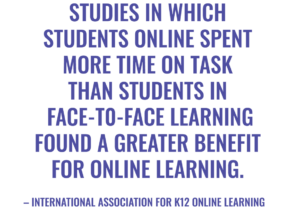 When the COVID-19 pandemic forced the sudden closure of schools everywhere, the shift to online courses was so sudden, there simply wasn’t time for adequate training on virtual learning. many teachers quickly discovered that to deliver a lesson effectively for each student and facilitate peer interaction wasn’t a simple undertaking. In this blog article, we’ll explore what research has to say about one of the components of the virtual classroom: The role of face to face or F2F communication and how it affects the brain.
When the COVID-19 pandemic forced the sudden closure of schools everywhere, the shift to online courses was so sudden, there simply wasn’t time for adequate training on virtual learning. many teachers quickly discovered that to deliver a lesson effectively for each student and facilitate peer interaction wasn’t a simple undertaking. In this blog article, we’ll explore what research has to say about one of the components of the virtual classroom: The role of face to face or F2F communication and how it affects the brain.
Does Online Communication Affect Student Virtual Learners?
Ask any teacher about the importance of face to face communication in their traditional physical classroom environment, and they’re likely to say it’s absolutely essential. Looking at faces of students while teaching reveals much. Teachers can tell who is actively engaged and who is “zoned out.” A perplexed or puzzled look on multiple faces indicates a need to pause, figure out what the students aren’t getting, and approach the point again from a slightly different angle. Watching interaction between students on group work adds another rich layer of feedback. Taking away the student face from the teacher is a major disruption to how they normally teach.
Education online can be handled any number of different ways, one of which is to have learners all present in a virtual classroom for online learning that allows teachers to see their faces. But it begs the question of whether the benefits of F2F communication can really be achieved when utilizing technology in online education courses.
Brain Research on F2F Communication
One fascinating study, Neural Synchronization during Face-to-Face Communication, the brains of participants were scanned as they engaged in different kinds of communication, including F2F and non-F2F modes of interaction. There was better “neural synchronization” between partners when the mode of communication was face to face dialog. In other words, face to face dialog resulted in more effective communication—and effective communication is one of the primary components of the education equation, including teacher and learner performance. The implication here is that the human brain has evolved to favor face to face communication, but modern communication technologies such as phones, text messaging, email, and so on, have increasingly taken away the F2F component and with it the benefits it brings to communication.
This study, however, didn’t directly address the question we’re trying to answer in this article, which is whether virtual classrooms utilizing live video conference technology for online lesson delivery come close enough to F2F dialog to confer its benefits to the learning process. Speaking with teachers who made the shift to online learning probably have widely varying opinions on whether or not the virtual classroom was an adequate replacement for F2F teaching where the teacher and students are in the same physical location, such as a room in a school. Most teachers would probably say it’s better than not having live video conferencing for virtual classrooms.
Academic Instruction in the Time of Coronavirus
Just about every teacher, parent, school staff member, and student has experienced extreme disruption of the last several months of the most recent school year. There is no doubt most would love nothing more than for the next school year to be a normal back-to-school return to traditional classroom learning on the school campus. Unfortunately, without a vaccine or effective treatment for COVID-19, it’s simply too early to tell what will be possible. What we have seen in states that opened up much quicker than others are surges in cases and hospitalizations, which gives pause to other states struggling to come up with a plan for the fall.
Program Options to Deliver Education in the Next School Year
Given the research noted above and how most teachers feel about the importance of F2F communication to teaching, whether physically in person or in the virtual classroom, it’s safe to say that most would not endorse a completely asynchronous approach to online education should it become necessary to limit school openings. With an asynchronous approach, students are not required to be online and can move through instructional content at their own pace. While all-asynchronous learning might be off the table for online learning, there may be room for blended learning, which could combine some asynchronous instruction with synchronous virtual classroom learning.
A blended learning approach could also even work in physical classroom instruction with small groups of students rotated in and out to maintain social distancing. A small group of students might be in a classroom one day, asynchronously working through online lessons the next day, and then in a virtual classroom for synchronous online instruction as a group. In this sense, the possible combinations are endless, though it would require a herculean effort in planning and coordination to pull it off. Figuring out how to respond in the face of so much uncertainty is no easy task. Creative approaches like the ones mentioned here in this article might hold the most promise for the coming school year.
Effective Virtual Classrooms: Lessons from Higher Education
Institutions of higher education have done more experimentation in recent years with various types of online education, including live virtual classrooms. But even at colleges and universities, many professors previously expressed disdain for online learning. One professor’s pre-pandemic experience at piloting a high-touch Zoom class is worth checking out. What he notes is perhaps obvious but has to mentioned: Long lectures where the teacher talks at students in a virtual classroom is every bit as uninspiring as it would be in a physical classroom. The key is make sure students are prepared for meetings of the online class and then immediately get into interactions, discussion, debates, questions and answers, and small group work using Zoom breakout rooms. Another of his articles, Flipping the Class without Flipping Out, is also worth a read. As you can see in these approaches in higher education, while the online lesson cannot be a perfect reproduction of physical classroom instruction, it is also true that just because the learning environment is virtual doesn’t mean it can’t also feature high levels of interaction and engagement.
Tips for Improving Virtual Classrooms
While many teachers are hoping they won’t have to repeat what for many was a pretty painful process of having remote online learning dumped in their laps without much time to prepare for it, you have to imagine this could and might happen again, not only this fall but in the future when something else like the novel coronavirus comes along and turns our lives upside down. And there’s just as much classroom management involved in the virtual environment as there is in the traditional classroom setting. Here are a few tips for teachers to keep in mind:
- Rules and Expectations: Make sure students fully understand the rules and expectations ahead of time by explaining them very clearly. And in your first meeting you can have an open discussion about them so students feel included in the process. The norms need to cover discussion etiquette (not interrupting), how to ask questions, respectful language, dress code (such as no pajamas), no device distractions, and so on.
- Decisive Discipline: If behavioral issues arise, discipline must be swift and decisive to show that just because this is a virtual classroom doesn’t mean students can get away with anything. Take a fun but firm approach, and include plenty of praise for positive behaviors.
- Inclusion: Just as you would in the physical classroom, make an effort to have everyone participating and included in discussions. Encourage questions.
Achieve Virtual Education Academy’s Online High School Program
The high school program offered by Achieve Virtual relies primarily on asynchronous instruction. The reasons for this are straightforward. We designed our program to serve students who need a much greater degree of flexibility in their education. Whether it’s a chronic medical condition that keeps them home, a work schedule that has to be accommodated, family caregiver responsibilities, or a host of other factors, there are many learners who either cannot attend the traditional brick-and-mortar school or would prefer not to. A primarily asynchronous approach is exactly what these students need and want. Our courses do build in plenty of interaction as well as all the individual support needed from the teacher for students to succeed.
Coursework with Achieve Virtual happens both when and where best suits the learner, and it is this flexibility that is at the core of what we do. Every course is taught by a real Indiana teacher who is fully certified to teach the subjects of their courses. Our online high school is fully approved by the Indiana Department of Education and is aligned with all state curriculum standards. Students enrolled with a full-time status pay nothing, while students enrolled with a part-time status pay modest fees per course.
If your family’s recent experience of online learning has revealed that the Achieve Virtual approach would work well for your high school student(s), learn more about our online high school by exploring our website or contact us directly by calling 317-988-7144. We’re always happy to answer any questions you may have!


